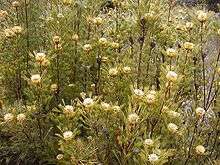Isopogon
| Isopogon | |
|---|---|
| | |
| I. cuneatus | |
| Scientific classification | |
| Kingdom: | Plantae |
| (unranked): | Angiosperms |
| (unranked): | Eudicots |
| Order: | Proteales |
| Family: | Proteaceae |
| Genus: | Isopogon R.Br. ex Knight |
| Type species | |
| Isopogon anemonifolius[1] | |
| Species | |
|
35 spp. | |

Isopogon anethifolius, Maranoa Gardens
Isopogon is a genus of 35 species of mainly low-growing and prostrate perennial shrubs in the family Proteaceae endemic to Australia. They are found throughout Australia, though Western Australia has the greatest variety with 27 of the 35 species found there. They are popularly known as drumsticks due to the shape of their inflorescences.
Several species are grown in gardens, though they are nowhere near as well known or cultivated as their fellow Proteaceae members Grevillea or Banksia.
Classification
They are members of the subfamily Proteoideae (which includes South African genera such as Protea, Leucospermum & Leucadendron), within the Proteaceae.
Genetics
Isopogon have 13 haploid chromosomes.[2]
Species
- I. adenanthoides (spider coneflower)
- I. alcicornis (elkhorn coneflower)
- I. anethifolius (narrow-leaved drumsticks)
- I. anemonifolius (broad-leaved drumsticks)
- I. anemonifolius "Woorikee 2000"
- I. asper
- I. attenuatus
- I. axillaris
- I. baxteri
- I. buxifolius
- I. ceratophyllus (Wild Irishman; Horny Cone Bush)
- I. crithmifolius
- I. cuneatus (Drumsticks)
- I. dawsonii (Nepean Cone Bush)
- I. divergens (Spreading Cone Bush)
- I. drummondii
- I. dubius (=roseus) (Rose Cone Bush; Pincushion Rose Bush)
- I. fletcheri
- I. formosus (rose coneflower)
- I. latifolius
- I. linearis
- I. longifolius
- I. mnoraifolius
- I. petiolaris
- I. polycephalus (clustered coneflower)
- I. prostratus
- I. scabriusculus
- I. spathulatus
- I. sphaerocephalus (drumstick isopogon)
- I. teretifolius (nodding coneflower)
- I. tridens
- I. trilobus (barrel coneflower)
- I. uncinatus
- I. villosus
References
- ↑ "Isopogon R.Br. ex Knight". Australian Plant Name Index (APNI), IBIS database. Centre for Plant Biodiversity Research, Australian Government. Retrieved 24 December 2015.
- ↑ Ramsay, H. P. (1963). "Chromosome numbers in the proteaceae". Australian Journal of Botany 11: 1. doi:10.1071/BT9630001.
- Foreman, DB (1995). "Isopogon". In McCarthy, Patrick (ed.). Flora of Australia: Volume 16: Eleagnaceae, Proteaceae 1. CSIRO Publishing / Australian Biological Resources Study. pp. 194–223. ISBN 0-643-05693-9.
External links
This article is issued from Wikipedia - version of the Wednesday, January 20, 2016. The text is available under the Creative Commons Attribution/Share Alike but additional terms may apply for the media files.